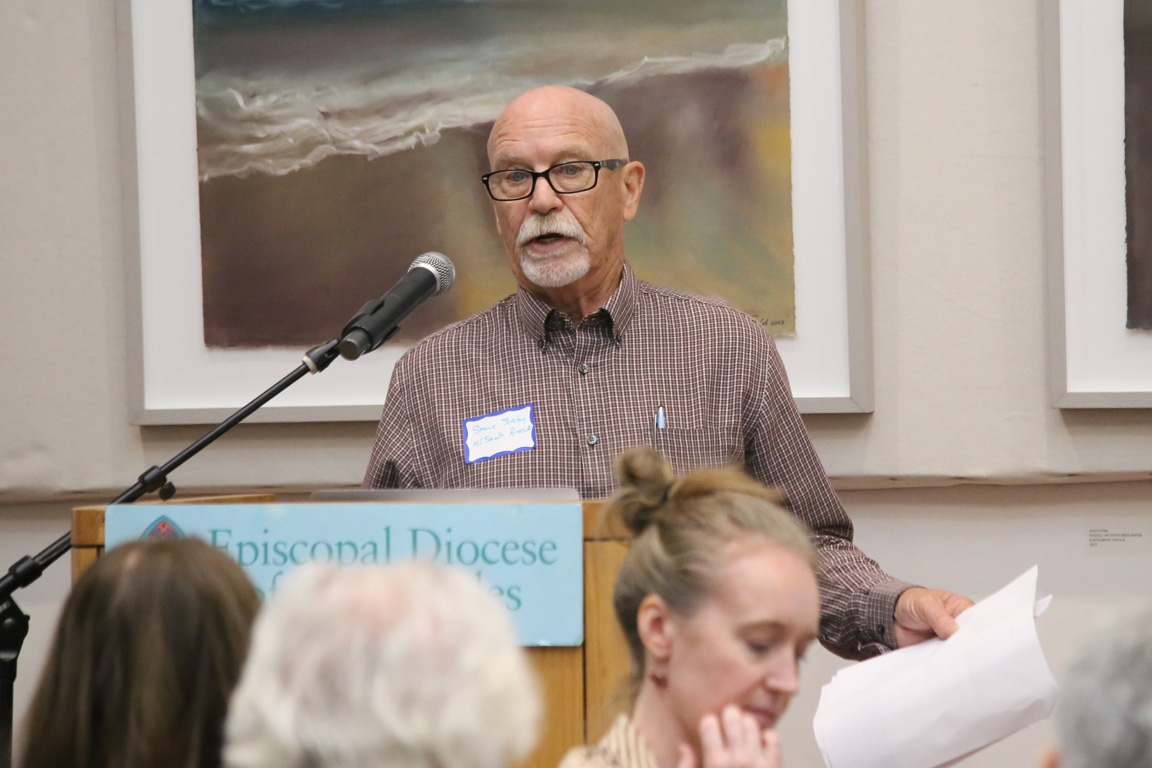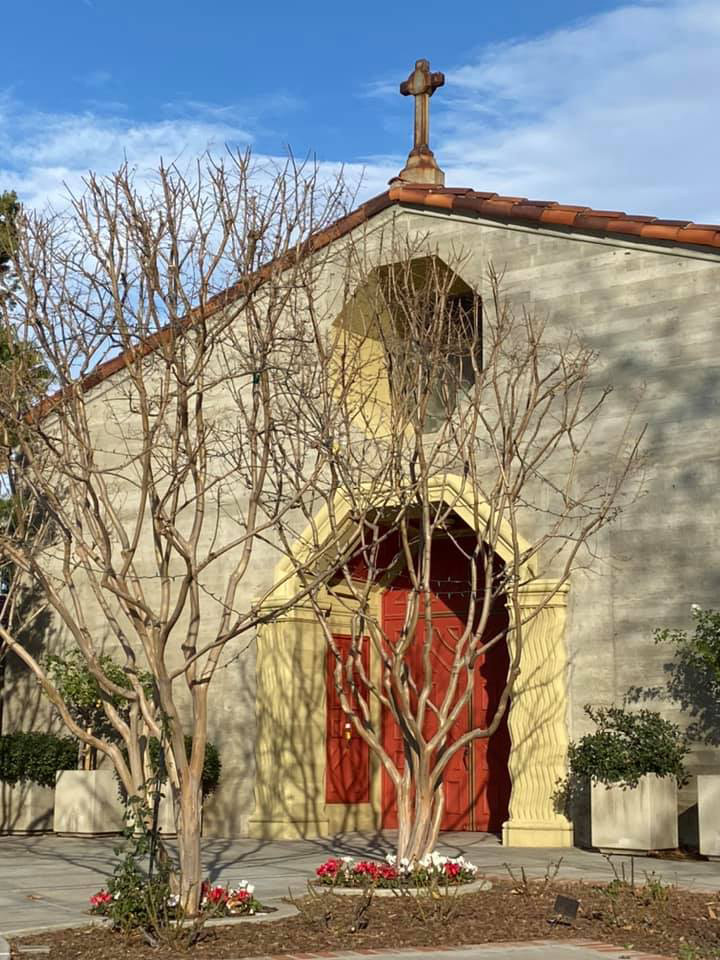Diocese of Los Angeles church negotiates path to sustainability, climate responsibility through solar powerPosted Jan 4, 2024 |
|

At the Climate Change Summit held on Sept. 16, 2023, at St. Paul’s Commons, Steve Slaten, junior warden at All Saints’ Church in Riverside, California, shares some dos and don’ts of installing solar panels, advice drawn from his congregation’s experience. Photo: Episcopal Diocese of Los Angeles
[Episcopal Diocese of Los Angeles] When completed, the approximately 60- x 30-foot steel pergola at All Saints Church in Riverside, California, will resemble a shade structure or patio cover. It will shield church members from the sun’s rays while solar panels on top collect power from those rays, leading to elimination of the parish’s monthly electric bill and possibly even turning a profit.
“We have this list of things we think God is calling us to do … just looking at all the different ways we can care for creation,” said the Rev. Kelli Grace Kurtz, rector of All Saints.
The church, a participant in the Dr. Lucy Jones Center for Science and Society program to increase post-disaster community resiliency in faith-based institutions, has been tackling that list in the interest of clean energy. Their efforts included removing an old gas stove in the kitchen, beginning a solar panel project and “a next big chapter would be installing electric vehicle charging stations and putting in LED lights,” Kurtz said.
“We got rid of the stove, capped off the gas lines and we’ve gone to a fully electric kitchen. The next big thing became obvious – that solar energy was something we needed to challenge ourselves to do, and it’s a challenge, a complicated process, much more than putting solar panels on your home.”
The congregation, including junior warden Steve Slaten, received a crash course in understanding Riverside Public Utilities, kilowattage and capacity and making sure the system envisioned would allow for the church’s energy needs and even possibly turn a profit. They also developed creative strategies to fund the $257,000.00 project.
Almost immediately, it became apparent that traditional rooftop solar panels wouldn’t work for the historic mission-style church’s tile roof. Initially organized as a mission in 1884, All Saints, located at the edge of the city’s historic district, was one of the first churches in downtown Riverside.
“The roof is old classic Spanish style. It was problematic putting those kinds of panels on that type of roof,” Slaten said. In addition to aesthetic appeal, issues of structural integrity could increase project costs. “You’d have to almost completely re-roof,” he said.
By taking “one step of courage” at a time, All Saints’ has moved forward in faith, Kurtz said.
“We kept praying about it and talking about it and preaching,” Kurtz said. “We did a Lenten study about what God says about our role as stewards of creation. And we started talking to solar companies. Through all of that we came up with the idea of building a pergola over our southern lawn.”
They’ve learned a lot, said Slaten, who is a member of the diocesan Bishop’s Commission on Creation Care and is willing to share those learnings with others.
A step at a time since 2020, the church connected with Opulent Power Solutions, a company that understood their unique needs and is now “drawing up the plans to submit to the city for approval,” according to Slaten, who has shepherded the project from its inception.
“It has been a two-year process of talking about it, figuring it out, praying on it, envisioning it, answering questions and concerns, making appeals and asking for members of the congregation to have a stake in the game,” Kurtz said. “This is a legacy project. We want the grandchildren of the children in our Sunday school to come back on campus as adults and say, ‘My grandparents were a part of making sure this church stayed, and that Riverside was a little cleaner. They participated in restoring creation and the climate in this part of the world.
“This is every bit as important in today’s world to do this kind of project as it was 75 years ago when people were courageous enough to build churches and install beautiful stained-glass windows.”
According to Slaten’s calculations, the stand-alone shade structure with solar panels will receive 100% exposure to the southern sun and should generate enough energy to not only pay the church’s monthly electric bill of about $1,500.00, but also generate overage that will be purchased by the Riverside utility company. The exact amount of return will depend on the amount of overage.
“We’ll be generating clean energy that will be used by others in the community,” he said. “As climate change progresses and we’re warmer for longer periods of time, we won’t outgrow our system. The energy we consume will be self-generating.”
Francie Johnson, former senior warden, said the cost savings potentially “frees up the money we’d normally be spending on utilities to put towards our programming in the community.”
The project will make All Saints “the leader of churches in city of Riverside who have made this commitment. It’s really exciting. We’ll be at the forefront of churches in city of Riverside to convert to 100% solar,” she said.
“The hard work and exhaustive research that Steve did to get to this point has become a good playbook for other churches and they have been in touch with him about how to wade through language and jargon and the different rules involved with federal rebates.”
Plans were formed during the pandemic, Johnson said, and “the silver lining was that we have a good, streamlined process to pass on to other institutions. We’re excited about doing this.”
Funds were raised through a capital campaign and the congregation aims to take advantage of the federal Inflation Reduction Act, which took effect Jan. 1, 2023, and gave nonprofits a minimum of 30% direct pay on the cost of overall solar projects, Slaten said. Churches in Los Angeles County that meet the regulations could gain as much as 70% return on the cost of the project from the federal government, he said.
All Saints’ capital campaign included several $25,000.00 and one $50,000.00 no-interest loans from members, added Johnson, a member since 1993. “Quite a few members have pledged also and already funded their pledges. Now we’re just waiting for the city to approve our permitting. Once we get that green light, we will be able to begin construction.”
“We could be plugged in at the end of March, but we just don’t know,” Kurtz said. She added that the financial savings are important but “if that is the only reason you’re doing this, you’re going to be frustrated. It’s a much longer-term investment.
“The spirituality of all of this is, we are called to be stewards of creation, to do what we can in a tangible way that models for the rest of the community what should be done.
“Once we understood this was a call as part of our faithful journey, that made all the difference. But you have to be determined; it’s a complicated process. You can’t do it alone.”
Participation in the Dr. Lucy Jones program “has been very helpful. It offered us a holistic commitment to the project, that it is good for the environment.”
Slaten agreed. “The journey has been very rewarding, and very frustrating. But now that we’re at the point we are, that we are ready to go, there is such a sense of thankfulness. I feel thankful and grateful that I happened to be in this place at this time at this location when it all came together. It’s felt like a redirected purpose. I feel incredibly lucky to have been here.”
-Pat McCaughan is a correspondent for The Episcopal News


Social Menu